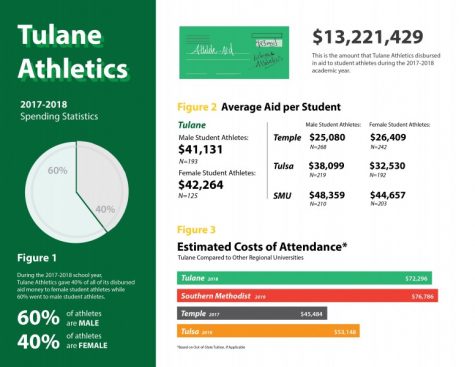Athletic programs’ budget offer look into student aid given to male, female athletes
Since 2003, the total amount of athletically related student aid given by private schools has more than doubled. Tulane alone gave $13,221,429 in athletically related student aid in the 2017-18 school year.
For the past eight reported years, however, Tulane athletics has held the ratio of male to female student athlete aid to approximately 60:40. Athletics’ decision to hold aid to this ratio is perhaps due to the difference in the number of participants on men’s teams and on women’s teams.
From 2010-18, the most recent years for which this data is available, roughly 60% of Tulane’s student athletes were male, while only about 40% were female.
The decreased female participation does not reflect the general make-up of the student body. As of the 2017-18 school year, 3,951 students or 60% of the Tulane student body identified as female, meaning that 3% of Tulane women are varsity student-athletes. Conversely, of the 2,765 Tulane men, about 7% are varsity student-athletes.
Furthermore, while there were only eight duplicated male counts of participation in 2017 — i.e. men who play more than one varsity sport — there were 48 duplicated counts of female participation.
When compared to Southern Methodist University and the University of Tulsa, Tulane’s private American Athletic Conference peers, and Temple University, a public university, however, Tulane does not always have the worst figures.
No men at Temple or SMU participated in more than one varsity sport, but there were 42 and 37 duplicated counts of female participation, respectively. Tulsa is the lone exception, with 65 male duplicated counts, but only 44 female duplicated counts.

Accordingly, in the AAC, it appears to be quite common for women to take on more than one role. Sometimes, the average amount of athletically related aid that female athletes receives relates this disparity, but this is not always the case.
When the total amount of athletically related student aid given to Tulane men is divided by the number of male athletes — $7,938,414 by 193 men — the average amount of aid received is $41,131.
When you perform the same calculation for the Green Wave’s 2017 female athletes — $5,283,015 by 125 women — the average amount of aid is $42,264, roughly equal to their male-counterparts.
Tulane’s average amount of aid given to its athletes is also toward the higher end of the spectrum, in line with the estimated $72,296 cost of attendance in 2018.*
Temple, estimated in 2017 to cost $33,724 in state or $45,484 out of state, provided the least amount of aid to its athletes.
The Owls’ male student-athletes received an average of $25,080 — $6,721,641 divided by 268 men, while their female student-athletes received an average of $26,409 — $6,391,176 divided by 242 women in 2017. Their total athletic aid budget was split at a ratio of 51:49 between their men’s and women’s teams.
Tulsa, estimated in 2019 to cost $53,148, had the highest disparity in athletically related student aid allocation.
In 2017, the average amount of aid received by Tulsa student-athletes — $8,343,792 divided by 219 men — was $38,099. The Golden Hurricanes’ female student-athletes received much less, with $6,245,922 divided by 192 athletes, averaging out to $32,530. Their total athletic aid budget was split at a ratio of 57:43 between their men’s and women’s teams.
SMU, whose estimated tuition in 2019 is $76,786, was the most generous school and the only one to surpass Tulane in terms of average aid given.
The Mustangs’ total student aid budget for its men’s teams was $10,155,580 while their 210 male athletes accordingly received an average of $48,359 in athletically-related student aid. SMU’s female athletes received an average of $44,657 — $9,065,440 divided by 203 women. Their total athletic aid budget was split at a ratio of 53:47 between their men’s and women’s teams.
Overall, Tulane athletics is certainly not the worst AAC school when it comes to investing equally in its student athletes. There are, however, improvements in recruiting funds and the overall number of athletes that can be made to make it an equal financial game for all.
*Because the most recent athletics student aid budget for all schools was reported for the 2017-18 school year, it is difficult to find cost of attendance data that matches that year. All reported COA figures are accordingly drawn from the closest available year.
Your donation will support the student journalists of Tulane University. Your contribution will allow us to purchase equipment and cover our annual website hosting costs.


